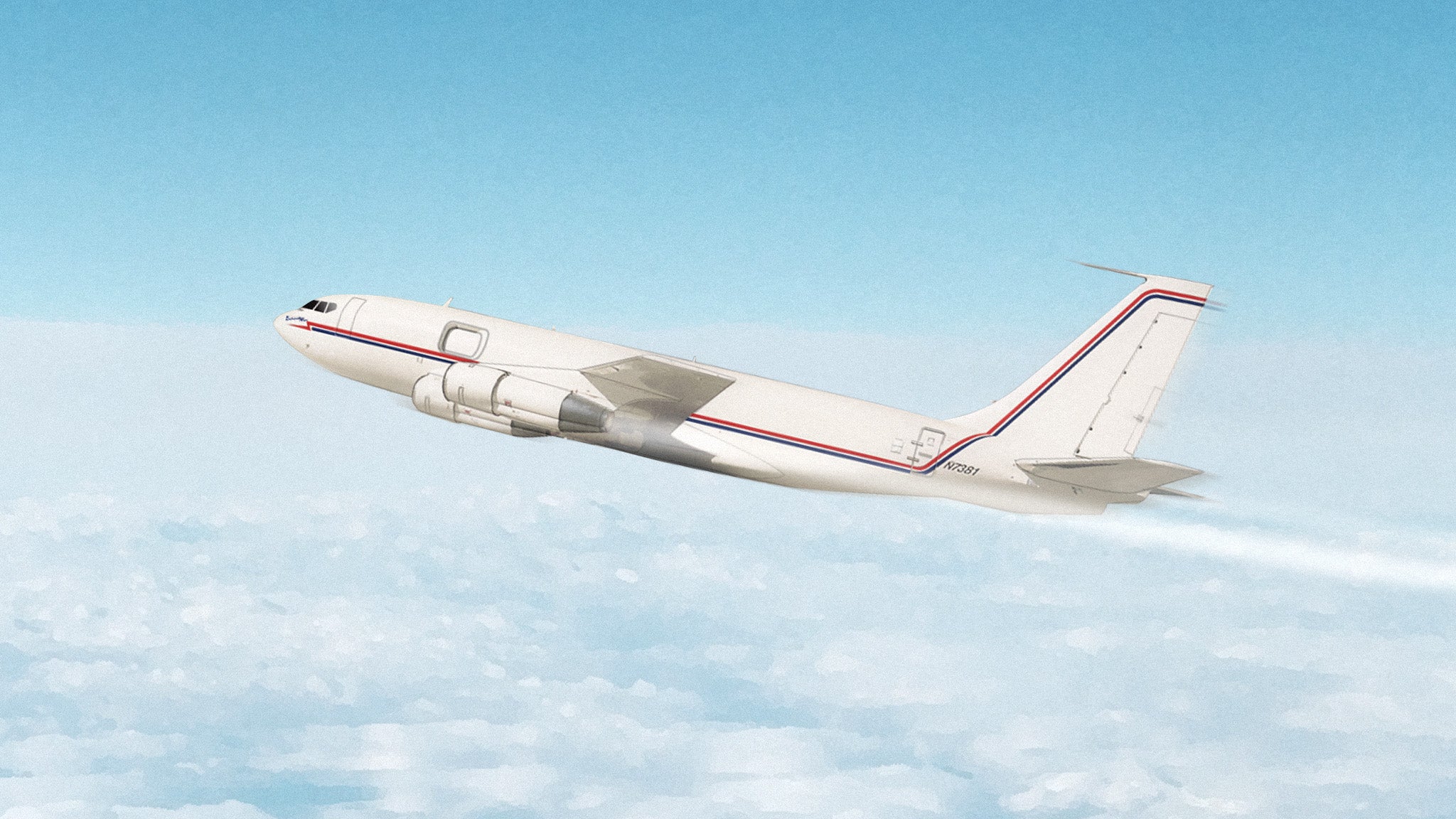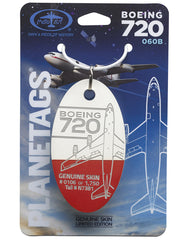
- by Dianna Lopez
Meet Embraceable Annie: A New Life for A Boeing 720
- by Dianna Lopez
A question? Visit our contact page
This site uses cookies for better user experience and analytics.

Another Boeing with a fascinating story from start to finish. Meet Embraceable Annie, a Boeing 720-060B that played an important role in the development of the Airborne Infrared Measurement System (AIRMS) and other breakthrough missile detection technologies. But there’s so much more.

Boeing’s 720 airliner was introduced in 1960, and right from the beginning it was unusual. It was Boeing’s first in the 7x7 series that doesn’t follow the numbering sequence. It was first designated as 707-020 but was changed to 720. It is sometimes thought of as just a shorter version of the 707, but there were many differences.
The Boeing 707 is often thanked for making air travel by jet accepted by the masses. It made its first flight December 20, 1957, was introduced commercially a year later, and within two years it became the popular way to travel for the jet set. To increase sales and take market share away from its competitor, the Douglas DC-8, Boeing began developing custom variants for different airlines. The 707-220 was modified for Braniff for high altitude flights and the 707-300 for long range flights for Qantas.

Similarly, United Airlines requested an aircraft - designated the 707-020 - that was shorter in length and designed to fly shorter routes from shorter runways. The plane was nearly identical to the 707 in appearance, but it featured many changes including a lighter structure and lower fuel capacity, and engine options that made it faster and more powerful. It was renamed the 720.
“The 707 was designated the 720 when it was modified for short-to-medium-range routes and for use on shorter runways. Engineers reduced the fuselage length by 9’ (2.7 meters), changed the leading edge flaps and later installed turbofan engines. Boeing built 154 720s between 1959 and 1967. Its short-to-medium-range role was later filled by 727s and 737s.” Boeing 720 Historical Snapshot
Our 720 (cn #18977), according to this Boeing 720 production list, was built as a 720-060B and took its first flight on September 1, 1965. It was registered as ET-ABP and delivered to Ethopian Airlines. It was dubbed Queen of Sheba.


Ethiopian Airlines, the flag carrier of Ethiopia, was founded in December 1945 as a joint effort between the Ethiopian government and TWA. It was financed by the government but managed by TWA, relying on mainly American personnel in the early years. Its first route was established in April 1946, flying a Addis Ababa - Asmara - Cairo route using one of the five Douglas C-47 Skytrains acquired from the U.S. government. The airline expanded its operations to international destinations by 1951, and today carries passengers to Europe, the Middle East, Asia, and North America. They celebrated their 75th anniversary on April 8, 2021 and kicked off “Celebrating 75 Years of Excellence”, a yearlong celebration.
Like many airlines during the jet age, Ethiopian Airlines sought to acquire its own fleet of jets to further expand. The airline ordered its first Boeing 720s in August 1960. The first 720 service took place in January 1963 with a direct flight from ADD to Nairobi. Just six months later, they expanded their destinations to include the cities shown on this timetable dated June 1963.

Thank you to Utopia Airport Blog for the invaluable route information and maps. Check out that link for more Ethiopian Airlines history.
On October 7, 1972, ET-ABP was operating Flight 708, an international passenger service to Addis Ababa–Asmara–Athens–Rome–Paris. 13 minutes into the flight, a purported group of five men and two women, members of the Eritrean Liberation Front, stood up and attempted to hijack the plane. A grenade, armed by one of the hijackers, was sent rolling down the aisle by a quick thinking passenger. It exploded in the unoccupied rear section of the fuselage, blowing a hole in the cabin floor and damaging several critical controls, including two engine throttles, rudder control, and horizontal stabilizer control. Security officers aboard the aircraft opened fire at the hijackers, killing six on the plane and a seventh later died in the hospital. The crew returned the plane to the airport safely. The damage sustained was repaired and ET-ABP returned to the sky.
A new life awaited this plane in the States. After retiring from over twenty years of service with Ethiopian Airlines, it then found a home with AAR and was re-registered as N440DS in January 1988. Within a few months, it was sold to Hughes Aircraft Co. and re-registered once again, as N7381. Its new life really began in earnest.
In aviation and aerospace development, a testbed is an airplane, helicopter or other aircraft which is used for flight research or to test on-board equipment or aircraft concepts. Many such testbeds are modified from serial production aircraft.
Some examples of test beds:
Experimental aircraft and test-beds have been used since the beginning of aviation history. Companies such as Rolls Royce continue to design new technologies and facilities to test and develop new aeroengine technology. Honeywell Aerospace operates a Boeing 757 testbed which tests engines, radar and other technologies being developed to increase safety. See additional Boeing Testbeds.
Learn more about Honeywell's test plane:
After being acquired by Hughes, N7381 was sent to Lockheed’s Greenville Operations facility for modification. Lockheed’s Greenville, South Carolina site is home to the highly skilled aviation technicians, engineers and personnel who work on the F-16 Fighting Falcon production line as well as provide modifications, maintenance, repair and overhaul for military aircraft. They installed an aero window, a 8’ x 6’ port on the left side of the forward fuselage. This port could be opened mid-flight.

The plane was returned to Hughes, and dubbed “Embraceable Annie”. Now part of a Defense Advanced Research Projects Agency (DARPA) project, Annie was transferred to the US Air Force in October 1993 and began a new career as part of Raytheon LAX Test Operations. The Airborne Infrared Measurement System was installed and data acquisition flights were run over Southern California, using MHV and Edwards Air Force Bases. Annie was returned to Hughes/Raytheon (the aerospace and defense operations of Hughes Aircraft had merged with Raytheon in 1997) January 17, 1997 and was retired to MHV at the conclusion of the program.
Annie was succeeded by “Sweet Judy”, a former American Airlines DC-10 (N124AA), and was used to continue the AIRMS testing and missile detection technology testing started by Annie.

When MotoArt owner Dave Hall found out that Embraceable Annie was at MHV, he knew the plane belonged in the PlaneTags fleet, not the scrap pile. “Of course, we needed a Boeing 720 to add to our growing Boeing collection,” says Hall. “Only 154 of them were made so you don’t run into them very often. Then to find out it played such an incredible role in this breakthrough technology - we were stoked.”




This very limited edition PlaneTag is numbered to 1,750 and will be available in White, Orange, Orange/White, Interior Green. Because it is a small run of an unusual aircraft - and our first Boeing 720 - we expect it to be met with a lot of enthusiasm by collectors and history buffs. They are available at planetags.com.





MotoArt has a new, very unique PlaneTag scheduled to be released August 5th. Follow our social media accounts (see below) and make sure you’re signed up for our eblasts and text messages so you don’t miss a thing. For the most up-to-date information, news, videos, and a forum to talk about this upcoming release, check out the MotoArt PlaneTags Facebook group.
Read about another experimental aircraft: INSIDE THE STRATOLAUNCH: THE UNITED BOEING 747 BEHIND THE GIANT PLANE
From Warbird to Water Bomber: The Epic Life of the Hawaii Mars
In the world of aviation, few aircraft have lived a life as large, or as long, as the Hawaii Mars. Towering over most of its contemporaries with a wingspan of 200 feet, this mighty flying boat was born in the final days of World War II, then quietly transformed into one of the most iconic aerial firefighting aircraft the world has ever seen. From military transport to firefighting titan, the Hawaii Mars represents one of aviation’s most extraordinary second acts.
In 2025, MotoArt obtained an original wing of this aircraft and created special PlaneTags, made exclusively for the Martin family members and Mars workers. On December 11, 2025, Hawaii Mars PlaneTags will be available to the general public for the first time.
F-14 Tomcat Coasters: A Legendary Fighter Reimagined for Your Home
Few aircraft define an era quite like the Grumman F-14 Tomcat. Sleek, powerful, and unmistakably iconic, the Tomcat was the Navy’s premier fleet defense fighter for more than three decades. From Cold War missions to pop culture stardom, the F-14 remains one of the most recognizable and beloved aircraft ever built. Today, MotoArt is proud to introduce the F-14 Tomcat Coaster Set, created from authentic F-14 aircraft material.
PR-AJB: The Story of an Azul Airbus A320 With a Global Journey
Every airplane has a story, and some travel farther than others before their flying days are over. PR-AJB was one of those well-traveled aircraft. This Airbus A320 started its life flying British families on long-awaited holidays, then later crossed the Atlantic to join the growing fleet of Azul Linhas Aéreas Brasileiras. Over nearly nineteen years it picked up new registrations, new paint, new routes and a new home, carrying thousands of passengers along the way.
Its journey reflects how widely the A320 family has spread around the world and how easily these aircraft adapt to whatever their next chapter requires. PR-AJB also arrived at Azul during an important period of expansion as the airline worked to connect more cities across Brazil. In this blog we will explore where the aircraft came from, what it did during its short time with Azul, and how it eventually came to rest in Florida. We will also share how MotoArt recovered material from the retired airframe and created PlaneTags so its story can continue in a new way.


Share:
C-54 Skymaster: The Mysterious Tanker 109
B-29 Superfortress: Meet Miss Liberty Belle